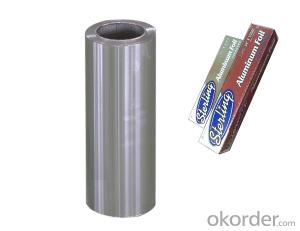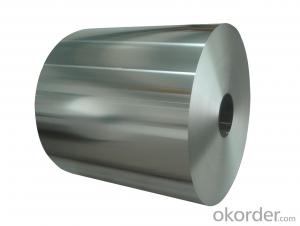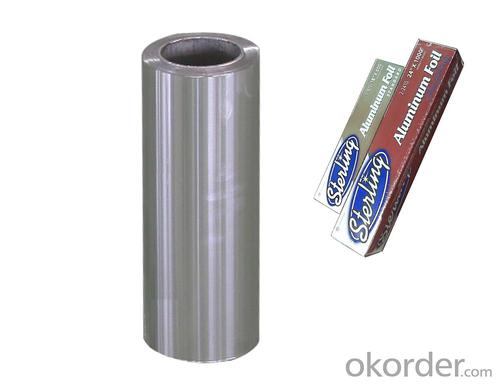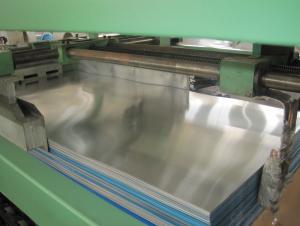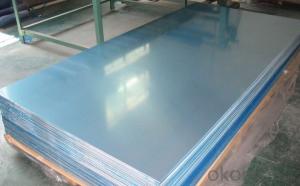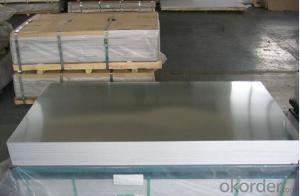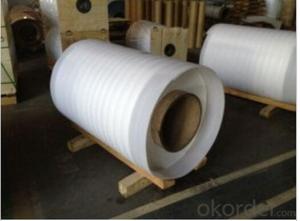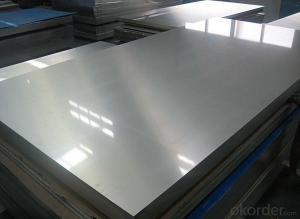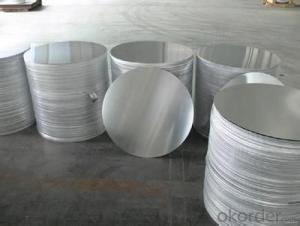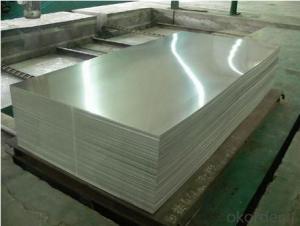Translucent Aluminum Oxide Sheets for Baking, Cooking in Restaurants and Hotels
- Loading Port:
- Shanghai
- Payment Terms:
- TT OR LC
- Min Order Qty:
- 1 m.t
- Supply Capability:
- 5000 m.t/month
OKorder Service Pledge
OKorder Financial Service
You Might Also Like
Our aluminium foil are mainly used for food packing.
Below are our best sellers specification for your reference.
9mic*29/30cm*75m
10mic*29cm*75m
10mic*29cm*150m
10.5mic*29cm*100m
| Alloy | 8011 |
| Temper | O |
| Thickness | 0.0065-0.02 mm / 6.5-20 micron |
| Width | 120 / 290 / 300 / 450 mm |
| Length | 7.62-200 meters |
According to different market, we offer below different packing ways.
Sell to restaurants or hotel: Each roll is wrapped with bubble film, 4/6 rolls per outer carton.
Sell to shops, stores or supermarkets: Each roll is wrapped with BOPP film, 24/36 rolls per outer carton. Or each roll is packed with color paper box with metal cutter, 6/12/24/38 rolls per outer carton. Outer carton has white and brown color.
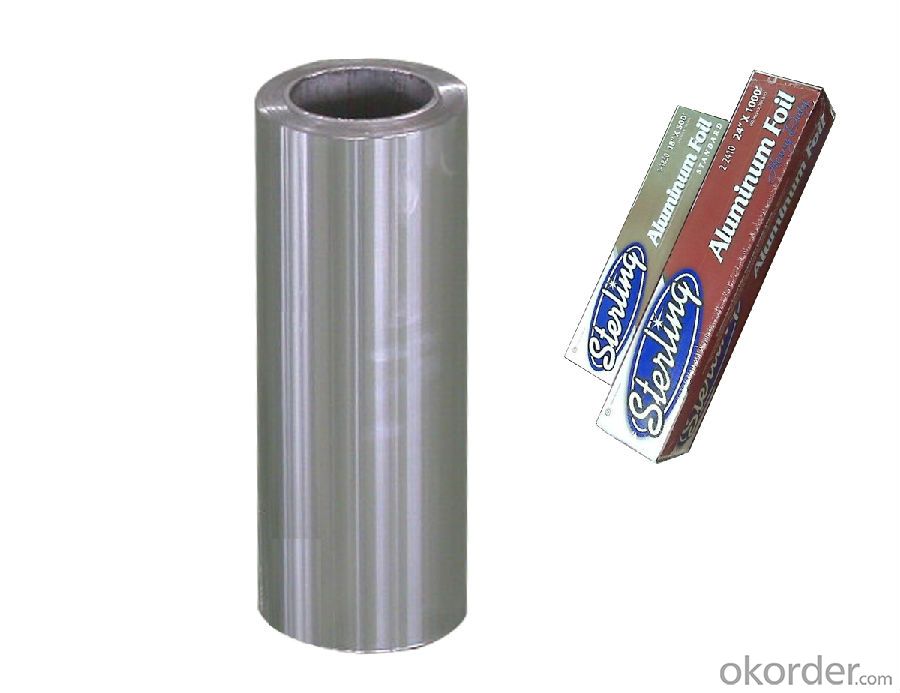
- Q: Can the aluminum sheets be used for manufacturing light reflectors?
- Yes, aluminum sheets can be used for manufacturing light reflectors. Aluminum is a highly reflective metal and is commonly used in various industrial applications, including the production of light reflectors. Its high reflectivity allows it to efficiently redirect and amplify the light, making it an ideal material for manufacturing light reflectors for applications such as lighting fixtures, automotive headlights, solar panels, and photography equipment. Additionally, aluminum sheets are lightweight, durable, and corrosion-resistant, which further enhances their suitability for this purpose.
- Q: What is the fatigue strength of 101 aluminum sheets?
- The fatigue strength of 101 aluminum sheets refers to their ability to withstand repeated loading and unloading cycles without experiencing failure or damage due to fatigue.
- Q: How is an aluminum sheet manufactured?
- An aluminum sheet is manufactured through a process called rolling, where a large ingot of aluminum is heated and passed through a series of rollers to reduce its thickness and increase its length. This continuous rolling process is repeated until the desired thickness is achieved, and the aluminum sheet is then cut into various sizes and shapes.
- Q: What is the elongation percentage of 101 aluminum sheets?
- The elongation percentage of 101 aluminum sheets typically ranges between 12% and 30%, depending on the specific grade and thickness of the sheet.
- Q: What are the different machining options for aluminum sheets?
- There are several different machining options available for aluminum sheets, depending on the desired outcome and the specific requirements of the project. Some of the most common machining options for aluminum sheets include: 1. Cutting: Aluminum sheets can be cut using various methods such as shearing, sawing, or laser cutting. Shearing involves using a shearing machine to apply a high force to the sheet, resulting in a clean and straight cut. Sawing, on the other hand, utilizes a saw blade to cut through the aluminum sheet. Laser cutting uses a high-powered laser beam to melt or vaporize the aluminum, resulting in a precise and accurate cut. 2. Drilling: Drilling is a common machining option used to create holes in aluminum sheets. This process involves using a drill bit to remove material from the sheet, creating a hole with the desired diameter. Different drill bits can be used to achieve specific hole sizes and shapes. 3. Milling: Milling is a versatile machining option that can be used to create complex shapes and contours in aluminum sheets. This process involves using a rotating cutting tool to remove material from the sheet, resulting in a precise and accurate finish. Milling can be done using various types of milling machines, such as vertical milling machines or CNC milling machines, depending on the complexity of the project. 4. Turning: Turning is another machining option used for aluminum sheets, especially when creating cylindrical or conical shapes. This process involves rotating the aluminum sheet against a cutting tool, which removes material and shapes the sheet to the desired dimensions. Turning can be done on manual lathes or CNC turning machines, depending on the level of precision required. 5. Bending: Bending is a common machining option used to create curved or angled shapes in aluminum sheets. This process involves applying force to the sheet, causing it to deform and take on the desired shape. Bending can be done manually using tools like a brake press, or it can be done using hydraulic or CNC press brakes for more precise and consistent results. These are just a few of the different machining options available for aluminum sheets. The choice of machining method will depend on factors such as the desired outcome, the complexity of the project, and the resources available. It is important to select the most suitable machining option to achieve the desired results efficiently and effectively.
- Q: Are the aluminum sheets suitable for manufacturing automotive body panels?
- Yes, aluminum sheets are suitable for manufacturing automotive body panels. Aluminum is a lightweight yet strong material that offers several advantages for automotive applications. Its high strength-to-weight ratio allows for improved fuel efficiency and better overall performance of the vehicle. Aluminum also has excellent corrosion resistance, making it suitable for withstanding harsh environmental conditions. Additionally, it can be easily formed and manipulated, allowing for complex designs and shapes required for automotive body panels. These characteristics make aluminum sheets a popular choice in the automotive industry for manufacturing body panels.
- Q: Can the aluminum sheets be used for manufacturing chemical reaction vessels?
- Aluminum sheets are indeed capable of being utilized in the production of chemical reaction vessels. The utilization of aluminum, a versatile substance, presents numerous benefits for this particular purpose. Its lightweight nature, durability, and exceptional resistance to corrosion render it suitable for the containment and interaction of various chemicals. Furthermore, the malleability of aluminum enables it to be easily molded and shaped into the desired design for the vessel, granting flexibility in the manufacturing process. Nevertheless, it is crucial to acknowledge that aluminum may not be suitable for all chemical reactions, particularly those involving highly corrosive or reactive substances. In such instances, alternative materials capable of withstanding the specific conditions of the reaction may prove to be more appropriate.
- Q: How do aluminum sheets perform in terms of machinability?
- Aluminum sheets are known for their excellent machinability. They can be easily cut, drilled, and shaped using various machining processes such as milling, turning, and drilling. Aluminum has a low melting point and is relatively soft, making it easier to work with compared to other materials like steel. Additionally, aluminum sheets have good chip control, which means they produce smaller and more manageable chips during machining. This reduces the risk of tool breakage and improves the overall efficiency of the machining process. Furthermore, aluminum sheets have good thermal conductivity, which helps dissipate heat generated during machining, preventing tool wear and prolonging tool life. Overall, aluminum sheets are highly machinable and widely used in various industries for their ease of machining and versatility.
- Q: What are the benefits of using aluminum sheets?
- There are several benefits of using aluminum sheets in various applications. Firstly, aluminum sheets are lightweight, making them easy to handle and transport. This characteristic is particularly advantageous in industries such as aerospace, automotive, and construction, where weight reduction is crucial for fuel efficiency and overall performance. Secondly, aluminum sheets offer excellent corrosion resistance. Unlike other metals, aluminum naturally forms a protective oxide layer when exposed to air, preventing further corrosion and enhancing its durability. This makes aluminum sheets highly suitable for outdoor applications or in environments with high humidity or corrosive substances. Another benefit of using aluminum sheets is their high strength-to-weight ratio. Aluminum is known for its exceptional strength, allowing it to withstand heavy loads or extreme conditions without compromising its structural integrity. This makes it an ideal choice for constructing lightweight but sturdy structures, such as building facades, vehicles, or industrial equipment. Additionally, aluminum sheets are highly malleable and ductile, meaning they can be easily formed into various shapes and sizes. This flexibility allows for intricate designs and customization, making aluminum sheets highly versatile and adaptable to different manufacturing processes or project requirements. Furthermore, aluminum is a sustainable and environmentally friendly material. It is 100% recyclable, meaning it can be reused repeatedly without losing its properties or quality. Recycling aluminum requires significantly less energy compared to the production of primary aluminum, resulting in reduced carbon emissions and a reduced environmental impact. Lastly, aluminum sheets have excellent thermal and electrical conductivity properties. This makes them suitable for applications that require efficient heat transfer or electrical conductivity, such as heat exchangers, solar panels, or electrical wires. Overall, the benefits of using aluminum sheets include their lightweight nature, corrosion resistance, high strength-to-weight ratio, malleability, sustainability, and excellent thermal and electrical conductivity. These advantages make aluminum sheets a popular choice in various industries, contributing to improved performance, cost-effectiveness, and environmental sustainability.
- Q: Are aluminum sheets suitable for high-temperature applications?
- High-temperature applications are generally not suitable for aluminum sheets. Despite its relatively high melting point of 660.3°C (1220.5°F), the strength and mechanical properties of aluminum decrease significantly as the temperature rises. Aluminum tends to soften, deform, and lose its structural integrity at elevated temperatures. Moreover, its relatively low thermal conductivity hinders efficient heat conduction away from the source, resulting in potential overheating problems. Hence, stainless steel or refractory metals like titanium or tungsten are commonly preferred for high-temperature applications due to their superior performance and thermal conductivity.
Send your message to us
Translucent Aluminum Oxide Sheets for Baking, Cooking in Restaurants and Hotels
- Loading Port:
- Shanghai
- Payment Terms:
- TT OR LC
- Min Order Qty:
- 1 m.t
- Supply Capability:
- 5000 m.t/month
OKorder Service Pledge
OKorder Financial Service
Similar products
Hot products
Hot Searches
Related keywords
